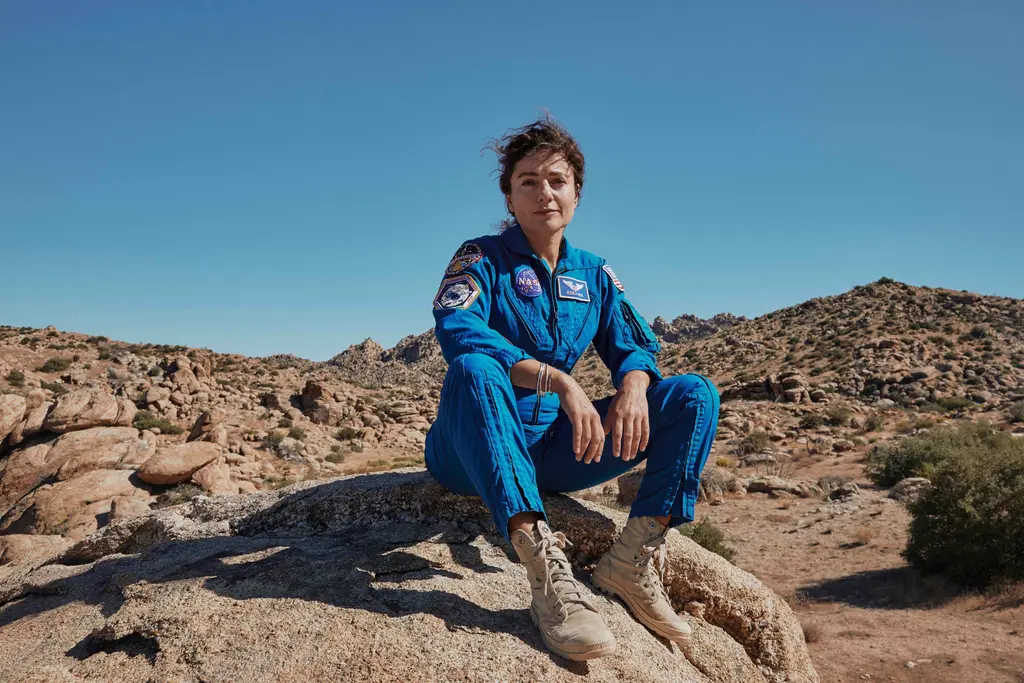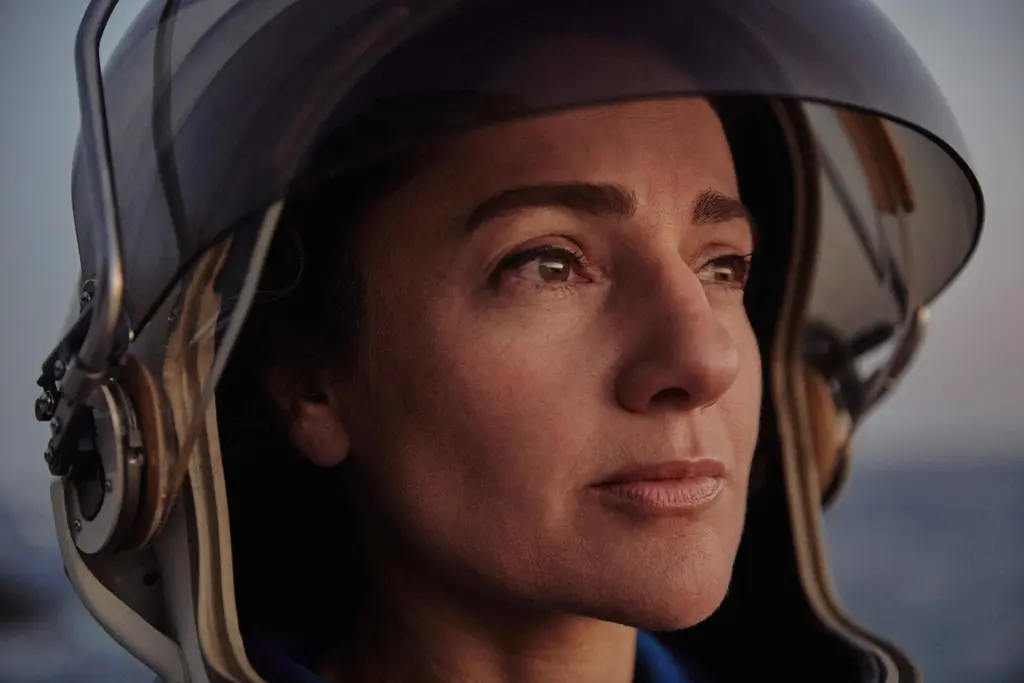The NASA astronaut who returned to a pandemic-ridden Earth

Jessica Meir completed her space mission in the middle of the Covid-19 pandemic after seven months on the International Space Station. Here, she reveals how it felt going from isolation to, well, isolation.
Life
Words: Alexandra Jones
Photography: Magdalena Wosinska
There’s a well-documented cognitive shift that happens when a person sees the Earth from space. Called the “overview effect”, psychologists who have studied the experiences of astronauts have likened it to an epiphany – a moment of profound mental clarity. “I’d heard others say that it changes you as a person,” says NASA astronaut Jessica Meir.
Leaving Baikonur Cosmodrome in Kazakhstan on 25th September 2019 – her first ever mission into space – the 43-year-old wondered whether it might change her too.
“It was pretty surreal. I felt like, how is this possible that I’m up here floating around, looking down at the entire planet? Other than thinking it was incredibly beautiful, I felt this profound sense of connection … it took a while to order my thoughts,” Meir recalls.
What Meir didn’t expect was that while she was gone, the world would change even more drastically. The culmination of her life’s work – a seven-month space mission – would coincide with the global Covid-19 pandemic. While the rest of us settled into lockdown, baking loaves of sourdough and bingeing bad TV, Meir looked down with an ever-increasing sense of “what the fu…’’
“The craziest thing to wrap my head around was that every one of the 7.5bn people on Earth was being affected by Covid-19, which didn’t even exist when we’d left,” she says. “Then there were the three of us up in space, completely separate from it.”
When Meir returned to the Johnson Space Center in Houston in April 2020 she was greeted by a world in deep lockdown. “It was like isolation after isolation,” she sighs. “I was a little depressed if I’m honest.” After a lifetime spent seeking out adventures, after achieving her dream of becoming an astronaut, after completing the first-ever all-female spacewalk, she was faced with the mundane reality of staying within the confines of her own home. “After living out of a suitcase for so long, I remember looking around my house and thinking: ‘What is all this crap?’”



Meir had wanted to become an astronaut from the age of five, so when at school a few years later, she was asked to draw a picture of her dream job naturally, she drew herself in a spacesuit. That would take a further thirty-something years of work, but in the intervening period she carved out a career which reads more like the plot of a Disney adventure film than the CV of a physiologist.
To understand how diving animals are able to hold their breath for long periods she spent almost a year on a “penguin ranch” in the Antarctic. “I loved the physicality of it,” she says. “Sometimes we’d just be shovelling snow all day, or catching penguins.” Predictably, they’re easier to catch on land.
As part of another experiment into the physiological adaptations of animals who can survive at high altitudes, Meir adopted 12 bar-headed geese in 2010. Twice a year this species migrates over the Himalayas, flying at altitudes of 24,000 feet – about the height of Mount Everest. She raised them from hatchlings – they’d follow her everywhere and take naps on her lap – and taught them to fly by riding ahead of them on a scooter down quiet country roads in British Columbia, Canada.
But it was always space, the ultimate adventure, at the back of her mind. “The thing that’s appealed to me, throughout my life and career, is being able to see and experience something that is wild and raw,” she says.
Docking into the International Space Station, she felt a growing sense of awe. The space station travels at 17,500mph, orbiting the Earth once every 90 minutes and travelling through 16 sunrises and sunsets in 24 hours. Floating over to the observation window for the first time, she found that she was struck by the beauty of Earth’s atmosphere which – despite how it appeared in photos – wasn’t a single blue band, but a whole hue of blues – a gradient that fades out to nothing as the air thins with altitude.
“The moon is 250,000 miles, Mars is 39,000,000 miles. There is so much left to see”
Watching the world go by again and again, Meir marvelled at the vibrancy of the colours and textures of the sand dunes in Africa, and how completely different they were to the dunes in the Middle East. “The view was incredible but so was the psychological aspect – the realisation that I was separate from every place I’d ever been to, everything I’d ever seen, every other human, and every experience I’d ever had, says Meir. “I was just an observer, and that was a lot to process.”
An average day in space involves experiments, repairs to the space station (“it’s pretty old now,” Meir admits) and around two hours of exercise. As well as either cycling or running, they’ll use a specially developed machine called ARED (Advanced Resistive Exercise Device) which generates resistance via vacuum tubes, to do zero gravity weight training. Without these mammoth daily workouts, long periods in zero gravity can have serious consequences including bone density loss as bones start to leach calcium, and muscle atrophy.
Astronauts then pack in the nutrients with dishes like Indian fish curry, Turkish stew and braised red cabbage with sweet and savoury kale. Even for a self-confessed food snob, Meir admits it’s pretty tasty – even if these meals come out of packets.
Missing the fancy presentation of a slap-up restaurant meal, she attempted to create a charcuterie board using condiments to stick down the cheese and meats so they wouldn’t float away. “There were only three of us up there at the time and my other two crewmates didn’t really care,” she says, with a laugh. “They weren’t excited about that element of food like I am, but they knew I was into it so they played along.”
Downtime was mainly spent staring out of the window taking pictures of the Earth below or “just floating,” Meir adds. “There are bungees on the floor so you can keep your position while you’re eating. I would use them to bounce up and down and spin around, or I’d pass food to my crewmates. Floating brings out the five-year-old in everybody.”
And then, of course, there were the spacewalks. Before she left earth, Meir asked her peers what she should expect from the experience. Most people found it hard to put into words. A few said they were scared. With nothing but the vast black abyss beneath them, they couldn’t quite shake the feeling that they were falling. For them, muscle memory took over; astronauts train for thousands of hours in their suits, repeating exercises to the point where the body can perform a task even while the mind is screaming in agony.



“Coming out of the airlock, I looked down and all I could see were my boots, and then nothing. I was like ‘holy crap, this is it, it’s actually happening.’” Seven hours and 17 minutes in the vacuum of space is a long time to feel like you’re falling. “Luckily I didn’t get that particular sensation,” she says.
Fear rarely factors into any of Meir’s stories, having dove beneath metres of Antarctic ice and spent seven hours with just a spacesuit between her and oblivion. “I don’t seem to have that fear response that we’re meant to as humans. Sometimes I don’t like to highlight that because psychologically, fear is a good thing.” Instead of fearing the experience, Meir worries what might happen if she doesn’t do it, and that without some level of risk won’t come a great reward at the end. “I think that’s how you have to live your life – willing to take a risk and willing to fail, in order to accomplish something really great.”
Having watched the Covid developments from afar, Meir was understandably reluctant to come back to Earth. “I would have stayed up there, for sure,” she says. “The things I was looking forward to most, like hugging friends and going to restaurants, weren’t available to me.” In fact, most of her post-space plans were cancelled thanks to the lockdown, which meant that she had plenty of time to think about how the experience had changed her.
“It’s still so difficult to describe what it feels like to see the entire Earth,” says Meir, struggling for words for the first time during our conversation. “Down here it’s so easy for us to get wrapped up in the minutiae of what we’re doing; something that’s superficial and inconsequential. When you’re in space, you are literally seeing the bigger picture – how special, fragile and beautiful our world is – this blue ball in the blackness of space. I wish that every human could experience that view, particularly our world leaders, to understand how important it is that we protect it.”
After two months at home, Meir left again driving to Boulder, Colorado to spend two weeks with her sister, hiking and camping in the Rockies. She admits she stopped caring about a lot of things soon after returning to Earth, noting that fresh air and sunlight was enough to bring her joy. “[I realised] possessions meant very little to me,” she adds.
Meir says that being in nature helped bring her back to Earth but, ever the adventurer, her gaze is still fixed on the stars.
“Going to the space station is incredible but it’s only 250 miles away from us right now,” she shrugs. “In the grand scheme of the solar system, it’s nothing. The moon is 250,000 miles away, and Mars is 39,000,000 miles. There is so much left to see.”







